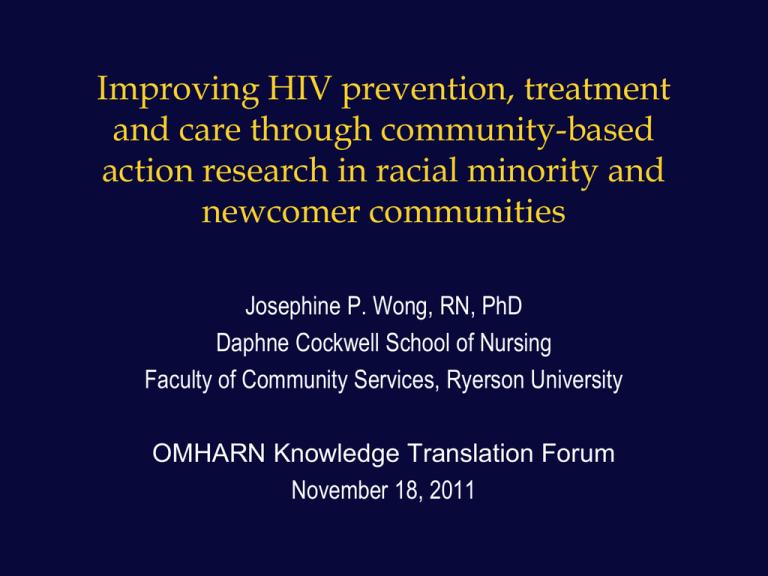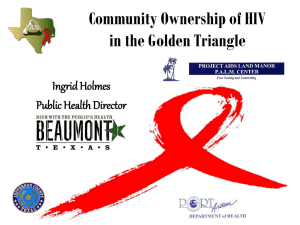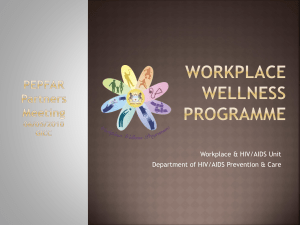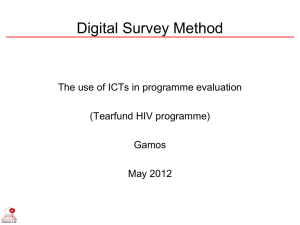
Improving HIV prevention, treatment
and care through community-based
action research in racial minority and
newcomer communities
Josephine P. Wong, RN, PhD
Daphne Cockwell School of Nursing
Faculty of Community Services, Ryerson University
OMHARN Knowledge Translation Forum
November 18, 2011
Committee For Accessible AIDS Treatment (CAAT)
• A coalition formed in 1999 to reduce
barriers faced by people living with
HIV/AIDS (PHAs) who are immigrants,
refugees or with precarious status in
Canada
• Coalition of over 40 health, legal and
social service organizations plus
individual immigrant/refugee PHAs
• Focuses on Empowerment Education,
Research, Service Coordination and
Advocacy on issues related to HIV,
Immigration and Access
2
Changing Demographics of HIV
• In the 1980s, over 80% of persons living with HIV/AIDS
were men who had sex with men (MSM)
• In 2009 – MSM (42%), heterosexual (31%), intravenous
drug user (22%)
• In 2009, over 67% of all reported HIV cases still did not
have information on race or ethnicity
• Among HIV case reports with ethnic or race information
in 2009, racialized new immigrants and refugees
comprised 22.5% of new HIV cases (PHAC, 2009)
• Over 40% of the people living with HIV/AIDS (PHAs) from
endemic countries contracted HIV after their arrival in
Canada (Remis et al., 2006)
3
Promoting the health of racial minority and newcomer
people living with HIV/AIDS (PHAs)
Research
& KTE
Practice:
Programs
/Services
Health &
QoL of
PHAs
Policy
4
2006-8 Improving mental health service access for
immigrant, refugee & non-status PHAs (IRN-PHAs)
Component 1: Explore
experiences of IRN-PHAs
• 47 participants
• FG & Interviews
+
Component 2: Experiences
of service providers
• 103 Service Providers
• FGs & interviews (37)
• surveys (66)
Component 3: Collective development of
Best Practices Framework
• 21 IRN-PHAs
• 6 research team members
• co-analysis recommendations
5
Summary of findings:
Key challenges faced by IRN-PHAs
MIGRATION RELATED:
- Pre/post migration
trauma & loss
Settlement/integrati
on
- Access to
determinants of
health (e.g.,
employment, trade
and professions)
- Legal barriers
STIGMA &
DISCRIMINATION:
- Racism
- Sexism
- Homophobia,
- Transphobia
- Xenophobia
- HIV stigma and
AIDS Phobia
- Etc.
ACCESS BARRIERS:
- Language barriers
- Cultural & social
inclusion
/competency
- Migration status
related eligibility
affecting health
care and service
access
- Stigma related
barriers
6
Best Practice Recommendations:
1
2
3
4
5
6
7
• Build capacity of IRN-PHAs
• Enhance social support among IRN-PHAS
• Support service provider training
• Improve service delivery and coordination
• Anti-stigma & anti-discrimination through public
education
• Address service inequities and improve accountabilities
• Bridge gaps in healthcare coverage through policy
change
7
Legacy Project: A structured
mentorship initiative
8
CAAT Follow-up : Research-Policy-Action
PHA SKILLS
BUILDING:
• Legacy
Mentorship
Project
• Newcomer
Sexual
Health
Promotion
project
SERVICE
PROVIDER
TRAINING:
• Designated
Medical
Practitioner
Training
• HIV and
Immigration
Access
Training
ANTI-STIGMA:
• MEL Study:
Mobilizing
Ethno-racial
Leaders
Against HIV
Stigma action
research
POLICY GAPS:
• Medical
Inadmissibility
Study
• Advocacy via
Mental Health
Strategy &
AIDS Strategy
9
The MEL Study: Mobilizing ethno-racial leaders against
HIV stigma and Discrimination (2009/2010)
Transformation through
Collective Empowerment
BACKGROUND
• Followed-up study from
recommendations of MH Access
Study to explore the challenges
and opportunities in engaging
leaders from ethnoracial minority
communities to address HIV
stigma and discrimination.
• seven focus groups – Recruited
22 faith, media & social justice
leaders and 23 PHAs from five
ethnoraical communities
•3 community forums – engaged
over 60 stakeholders
10
Cycle of Social & Internalized HIV
Stigma/Discrimination
Societal Stigma &
Discrimination
Denial & ‘Othering’
undermine HIV
prevention/support
efforts
Lack of PHA and
ethnoracial community
leaders to champion HIV
issues
STIGMA
Unsafe social
environment for HIV
disclosure
PHA non-disclosure
‘invisibility’
community emotional
disconnection
11
Key Follow-Up Action Strategies &
Study Recommendations
• Reclaiming HIV as an important health and
fundamental human rights issue concerning
everyone
• Facilitating critical dialogues within and across
the target sectors to address the cognitive and
affective knowledge gaps related to HIV/AIDS
• Developing strategies to reduce internalized
stigma and external stigma / discrimination
12
Follow-up Research: CHAMP STUDY
Community Champions HIV/AIDS Advocates Mobilization Project –
An intervention study to:
• Engage ethnoracial and newcomer PHA and Non-PHA leaders
• Pilot and evaluate 2 interventions:
– Acceptance Commitment Training, and
– Social Justice Capacity Building Training
• Evaluate effectiveness of these 2 intervention in
– addressing social and internalize HIV stigma
– Mobilizing PHAs and non-PHAs to become HIV champions
13
Promoting the health of racial minority and newcomer
people living with HIV/AIDS (PHAs)
Research
& KTE
Practice:
Programs
/Services
Health &
QoL of
PHAs
Policy
14
THANK YOU
CAAT Coordinator: Maureen Owino
<MaureenO@regentparkchc.org>
Legacy Project Coordinator: Derek Yee
<DerekY@regentparkchc.org>
Newcomer SH Promotion Project: Godelive
Ndayikengurukiye <GodeliveN@regentparkchc.org>
CAAT Co-Founder & OHTN CBR Research Scientist:
Dr. Alan Li <AlanL@regentparkchc.org>
CAAT Researcher & Associate Professor, Ryerson
University: Dr. Josephine P. Wong <jph.wong@ryerson.ca







